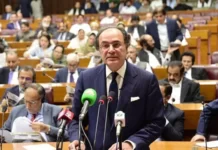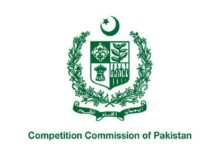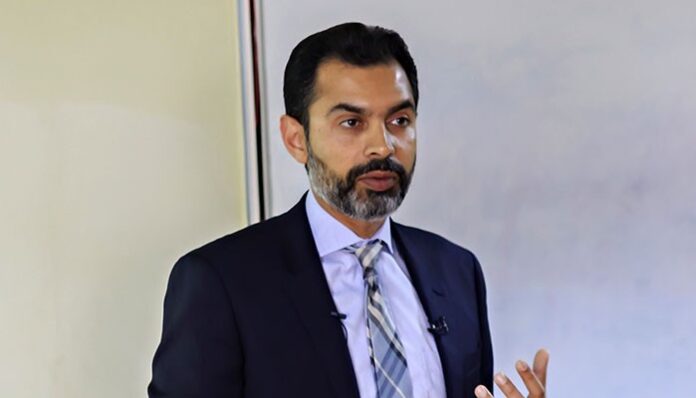KARACHI: State Bank of Pakistan (SBP) Governor Dr Reza Baqir during a podcast said that communication was key to the central bank’s success.
During the podcast arranged by Macro Hive, the SBP governor expressed his views regarding Pakistan’s economy, markets, Covid-19 and Emerging Markets (EM) debt reduction.
At a time when uncertainty haunts households and businesses around the world, Baqir was certain that the key to central bank’s success lies in communication. There are three contexts in which this cropped up during the podcast.
Moving from fixed to market-based exchange rate
The SBP governor described the transition towards a market-based exchange rate as ‘swimming upstream in a river’, indicating that ‘[the] need to sell dollars to prevent a currency from depreciating’ is a never-ending process that causes structural impediments.
Moving to a market-based regime (a rate primarily determined by supply and demand, but which does leave room for the central bank to intervene during disorderly market conditions) enables the exchange rate to move both ways and is less costly for the balance sheet
In order to enable this transition the central bank, halved the deficit prior to the regime change, the government announced it would not borrow large amounts from the state bank; the rupee was allowed to depreciate significantly so that much pent up excess demand for the dollar had already been allowed to be reflected in the exchange rate and the interest rates were raised by the state bank.
The governor said that he is aware that some corporate firms may struggle with the resulting exchange rate volatility, but said that, over time, they would learn to manage inflows and outflows themselves (although he emphasised that the central bank would be there if there are disorderly market movements).
Using inflation expectations as a nominal anchor
Without an exchange rate anchor, the country needed to anchor expectations against inflation effectively. For this, the central bank began to reorient monetary policy statements, placing an emphasis on expected inflation. So far, the SBP believes good communication has successfully enabled the market to make this transition. Surveying inflation forecasters, it found that market predictions have converged on a range that the state bank had expected.
How did they do it? Firstly, the state bank announced at the start of the fiscal year that it expected inflation to be, on average, 11-12 per cent. Furthermore, at the end of every monetary policy meeting, the state bank held closed door discussions with leading market analysts. This was done to convey trust to the wider business community, which the governor says have, on occasions, had good reason to mistrust public information. The focus of these meetings was to discuss policy decisions, expected inflations and state bank forecasts.
Using informal connections as a good source of information
Baqir is not the only governor to be navigating his way through turbulent times. In response to a question around communication between central bank governors, he responded: ‘Only one governor can appreciate the pain, the constraints, the challenges of another governor, especially when you’re dealing with such a powerful external shock’.
He then continued to say that he has had discussions with other central bankers and that ‘informal communication is the most reliable and biggest source of high-quality information’.
Pakistan’s economic state prior to Covid-19
Answering a question regarding Pakistan’s macroeconomic state prior to the pandemic, Baqir made it clear that, in the context of an overvalued exchange rate, a historically low savings rate and a central bank with insufficient reserve holdings, the $2 billion a month current account deficit and primary fiscal imbalance of more than 1 per cent of the Gross Domestic Product (GDP) are impairing Pakistan.
He said that the solution requires a radical adjustment of the imbalances, a recognition that the governor admits came right from the top. “The stabilisation that we achieved from July 2019 to March 2020 would not have been possible without the ownership at the very highest possible level. Prime Minister Imran Khan recognised the depth of the problem and the need for adjustment,” the SBP governor said.
This adjustment came in the form of a reform package, supported by the International Monetary Fund (IMF), which began in the middle of last year.
Baqir said that at the heart of the difficult reforms were two things. One, the country needed to transition from a fixed exchange rate regime to a market-based one. Second, it needed to increase the amount of reserve holdings. The latter, according to the governor, has historically been the best predictor of when Pakistan has needed to go to the IMF. Due to Pakistan’s savings/investment gap, the country has had to borrow. In the context of a fixed and overvalued exchange rate, there have been occasions where Pakistan has had insufficient reserves to meet foreign exchange obligations. This is what the governor said he is hoping to avoid in the future.
Response to the ‘mother of all external shocks’
Without a doubt, the major transitions Pakistan has had to go through over the last year would have been easier without what Baqir describes as ‘the mother of all external shocks’. Nevertheless, the timing of the adjustments has probably helped mitigate some of the economic downside to Covid-19. As it stands, several core macroeconomic indicators have improved, which has ‘only been made possible through difficult reforms’.
Nevertheless, the relatively fragile state of EM countries, which includes Pakistan, has meant the policy responses to the pandemic have been measured. The higher level of public debt and lower foreign reserves mean that if macroeconomic indicators worsen, EMs could be left in a very vulnerable position post Covid.
Innovative monetary policy
Given the macroeconomic constraints, there has been a push towards innovative monetary policy measures in response to Covid-19. On this front, the SBP governor emphasises the need to focus on quantities as well as interest rates. Since the onset of pandemic-related economic pressure, the State Bank of Pakistan has dropped interest rates by 625bps, the largest cut in EMs, apart from Argentina, introduced a presumptive one-year extension in principle payments of borrowers to banks, doubled the period (to 180 days) in which a bank’s clients can restructure their loans, introduced concessional credit facilities for payroll financing targeting job savings.
Baqir is positive on the uptake of these schemes, suggesting that the impact of all these measures has been about 3 per cent of GDP.
‘The worst is behind us’
Altogether, Baqir said that the reforms have moved the macroeconomic landscape in Pakistan towards an environment that is more equitable and supports sustainable growth. In addition, if the country can maintain the current improvement in terms of the health crisis, the governor believes there is room to be optimistic about the future.
“Today, when I look at the future, I am quite confident that the worst, in terms of financial turmoil, is behind us,” he says.
The SBP governor says that there are a number of indicators that are moving in the right direction. The current account deficit has fallen tenfold. In monetary terms, it has reduced to about $200 million a month by December 2019. One of the key reasons for this was the adjustment of the exchange rate.
In the most recent fiscal year, the primary fiscal balance has moved to a surplus. Exports are starting to recover, however, the SBP governor says that Pakistan needs to monitor remittances closely.
Moreover, since the start of the year, growth reserves grew by about $5 billion, and net reserve buffers have doubled the amount on the books (from $7 billion to $14 billion).
Similarly, according to Baqir the transition to a market-based exchange rate has been successful.
Baqir concluded that despite big strides forward, there are three main priorities that the state bank is striving towards which include increasing exports, financial inclusion and promotion of savings.

























Thanks my sbp gvrnar Rzabaqir sahb im wetang you great man my Mother’s you fory 5kror ropee pakistani currency my mother house transfer thanks